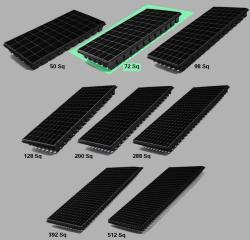No problem Frilly. They are plugs roughly 1 1/2 inches in size. Liners are in the 2" range.
The illustration below is of the various cell trays used by growers. These hosta would have been grown in the 72-cell tray (highlighted in green.) I would suggest potting these up into larger pots with a well-draining 'soil' mix. Someone here on the NGA site said that the disposable 16oz plastic drink cups that you can get at a dollar store are great for starting plants. (I keep forgetting to get some every time I go to the dollar store!).
Before you put anything in the cups, poke a few holes in the bottom for drainage. Take a small-ish screw driver and heat the tip using your stove. When it is hot, push it through several cups at a time. Repeat the process until you have at least 4 holes.
Fill the cup 2/3 full with potting medium. Hold the plug so that the crown is about 1/4 to 1/2 inch below the rim and fill around with more potting medium. Once they're all potted, water them well.
Some are going to say "why bother, I'll just go to a big box store or nursery and buy larger plants." That''s fine. If you need something to fill a space
now. (While on a trip to New England a couple of weeks ago, we picked up a nice, large hosta... at
$33.00. It's like some smaller ones that we already have, but Larry wanted a 'big plant'. When I went to plant it, I removed it from the pot only to fine that it had been recently, within a week, moved from a 1 quart pot to a 2-gallon pot. The roots hadn't even started to spread out beyond the confines of the old pot.)
Something else to keep in mind is that we're headed into the really hot season. By getting smaller plants, you can put them somewhere where you will be able to monitor their health and water when needed, not when it's too late.
Late September through mid-October, plant out your new hosta into their 'permanent' home the garden. The few months they spent in pots will allow the roots to grow and develop, increasing their chance of survival during the winter.
I hope this helps.

The following is from
http://homeguides.sfgate.com/p...
Plugs and liners are basically starter plants or seedlings available at greenhouses or nurseries. This means the delicate process of establishing a plant from a seed or cutting is done for you. Plugs are young plants that have been grown from seed in separate cells of greenhouse trays. Liners are young plants that are typically grown from cuttings. They are rooted in greenhouse trays like plugs, but these trays tend to be larger and narrower than plug trays.
Inspection
When you get your plugs and liners home, it is important to their health and the health of existing plants, to inspect each plant to ensure it is vigorous and free of pests and disease. Look for common insect pests such as aphids, spider mites, thrips and whiteflies. If unnoticed, these particular pests can populate your plants rapidly. Use a magnifying glass to inspect all parts of your plugs and liners. Light infestations can be rinsed away with water. Heavy infestations may make it necessary to destroy a particular plug or liner. Another option is to isolate the plugs or liners and treat with horticultural oils or insecticidal soaps prior to transplanting.
General Care
Plugs and liners require fresh air and should be kept in a well-ventilated and well-lit area that is free of cold drafts for about 24 hours after you bring them home. When you remove plugs and liners from their trays, do not remove the netting, as it keeps the soil and roots intact. This won’t inhibit root growth once the plug or liner is planted. Make sure that the plugs and liners are always upright, and not lying on their sides. Plant into the desired containers or beds as soon as possible but not before the soil has warmed enough for your particular plant to establish itself.
Preparing for Transplanting
Before you transplant plugs and liners into the garden, feed them in their trays with a liquid fertilizer solution that is labeled for feeding your particular plant. This helps promote early growth and can reduce transplant shock. Water your plants and liners to keep the soil moist, but not soggy until you are ready to transplant them into pots or your garden. If you’re keeping your plugs and liners outdoors, a shaded location can help prevent drying out of the soil and minimize problems. Harden off your plugs and liners before transplanting outdoors by placing them outside during the day and bringing them in at night. Do this for about two weeks.
Planting
Water your plugs and liners about one to two hours before planting. Remove the plug or liner from its tray by pushing up on the bottom. When you plant your plugs or liners, cover the netting with 1/4 to 1/2 inch of soil, but no more than this. If you are not yet ready to plant in the garden, transfer it to a small pot or a seed tray that is filled with general purpose compost. Water the planted plugs and liners thoroughly at planting and then do not water again until the soil feels dry. In the days following transplant, keep the soil consistently moist, but not soggy. After the first week, reduce watering to weekly intervals, or as required by your particular species of plant.
